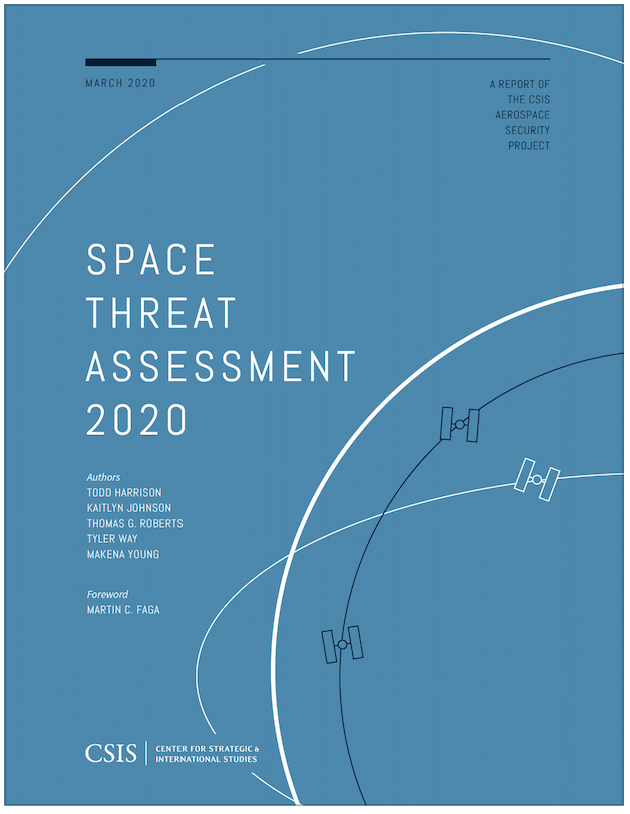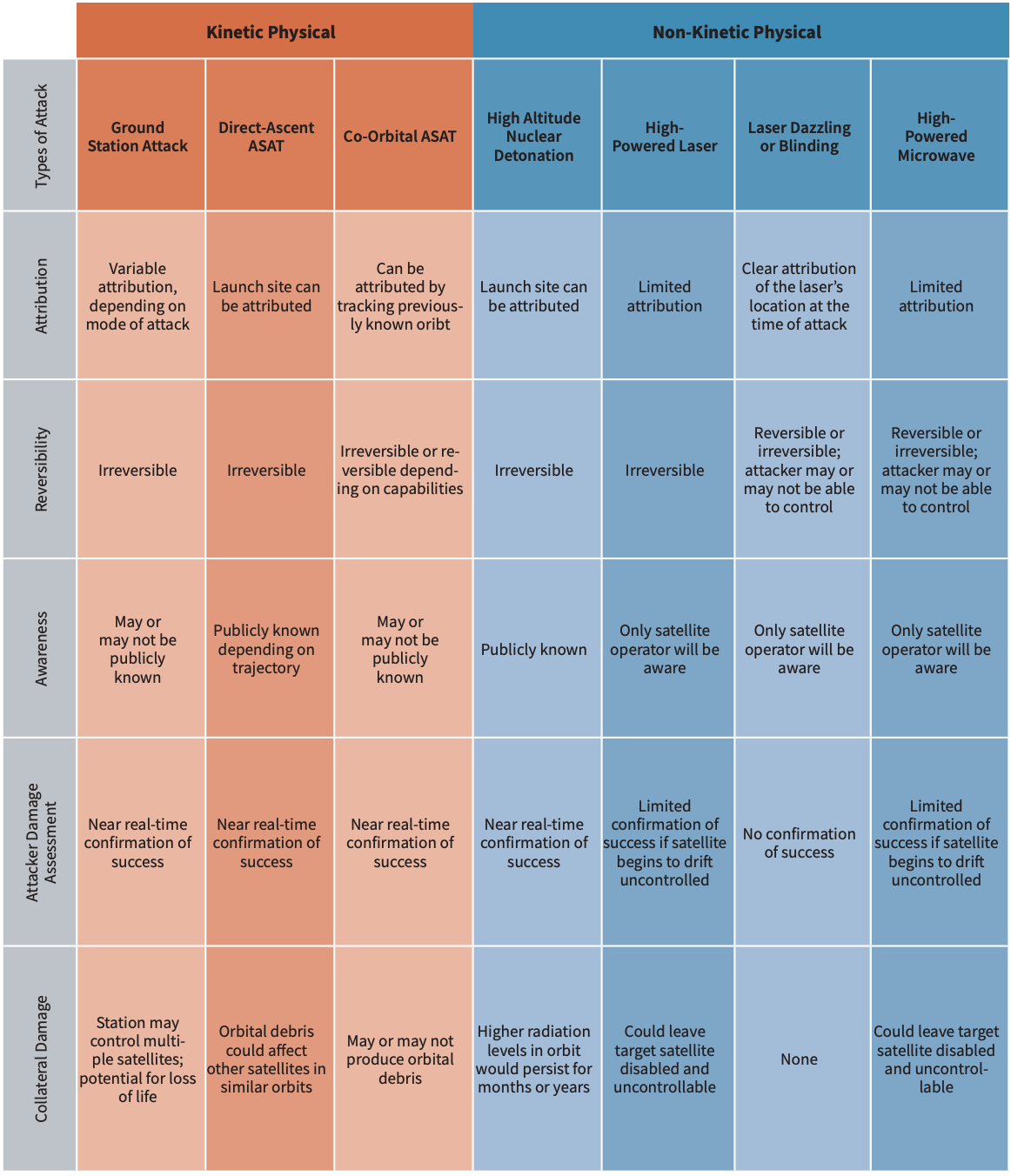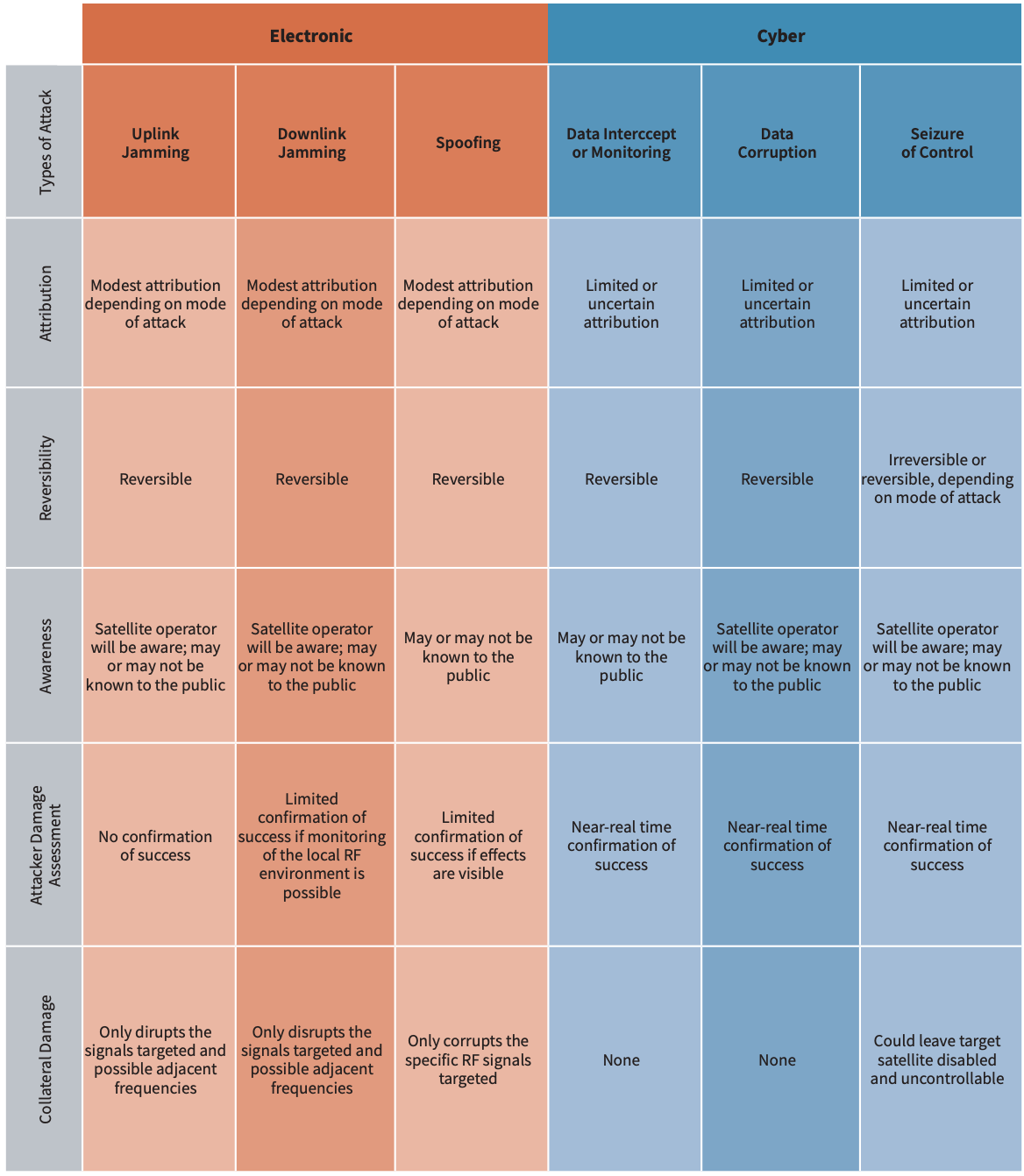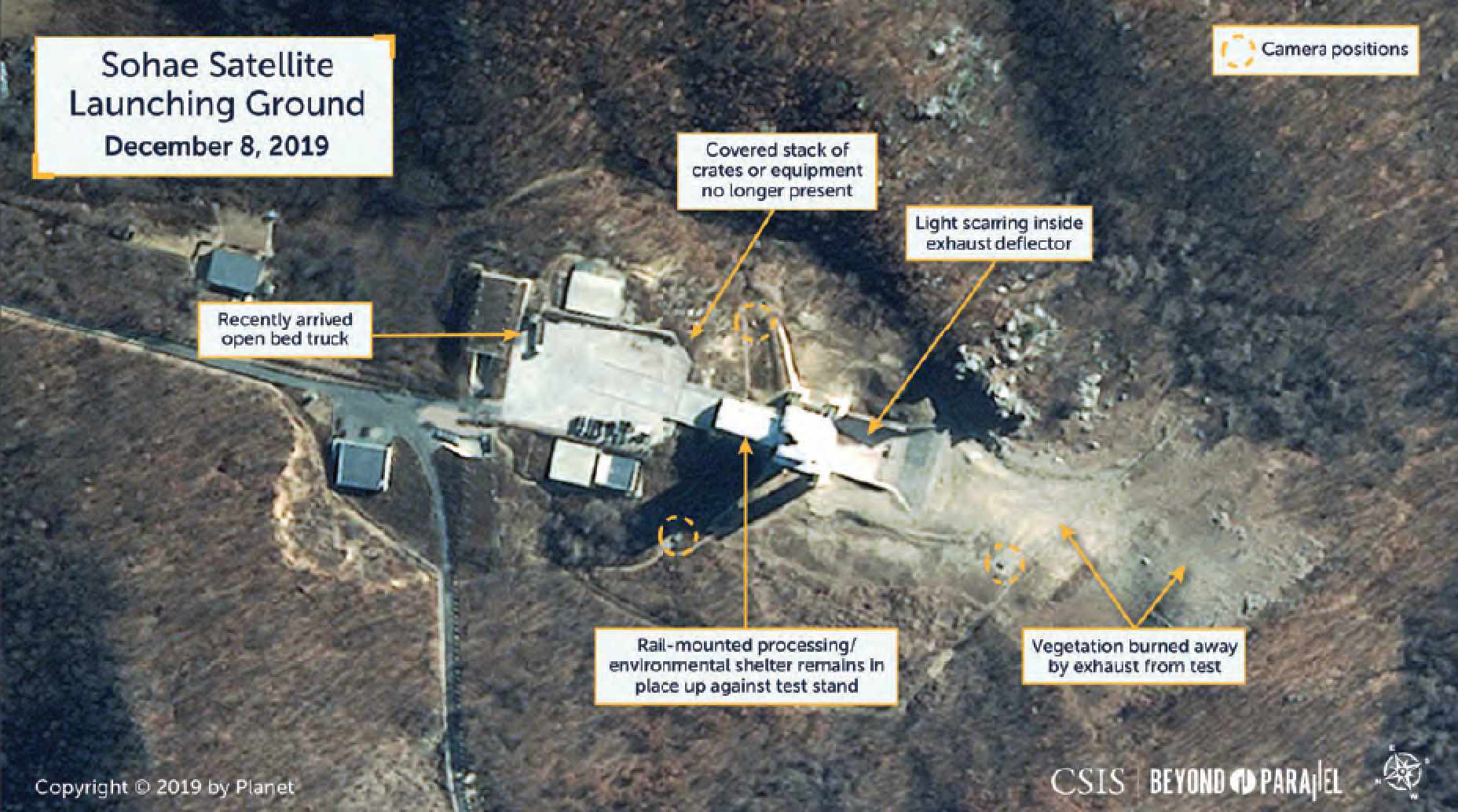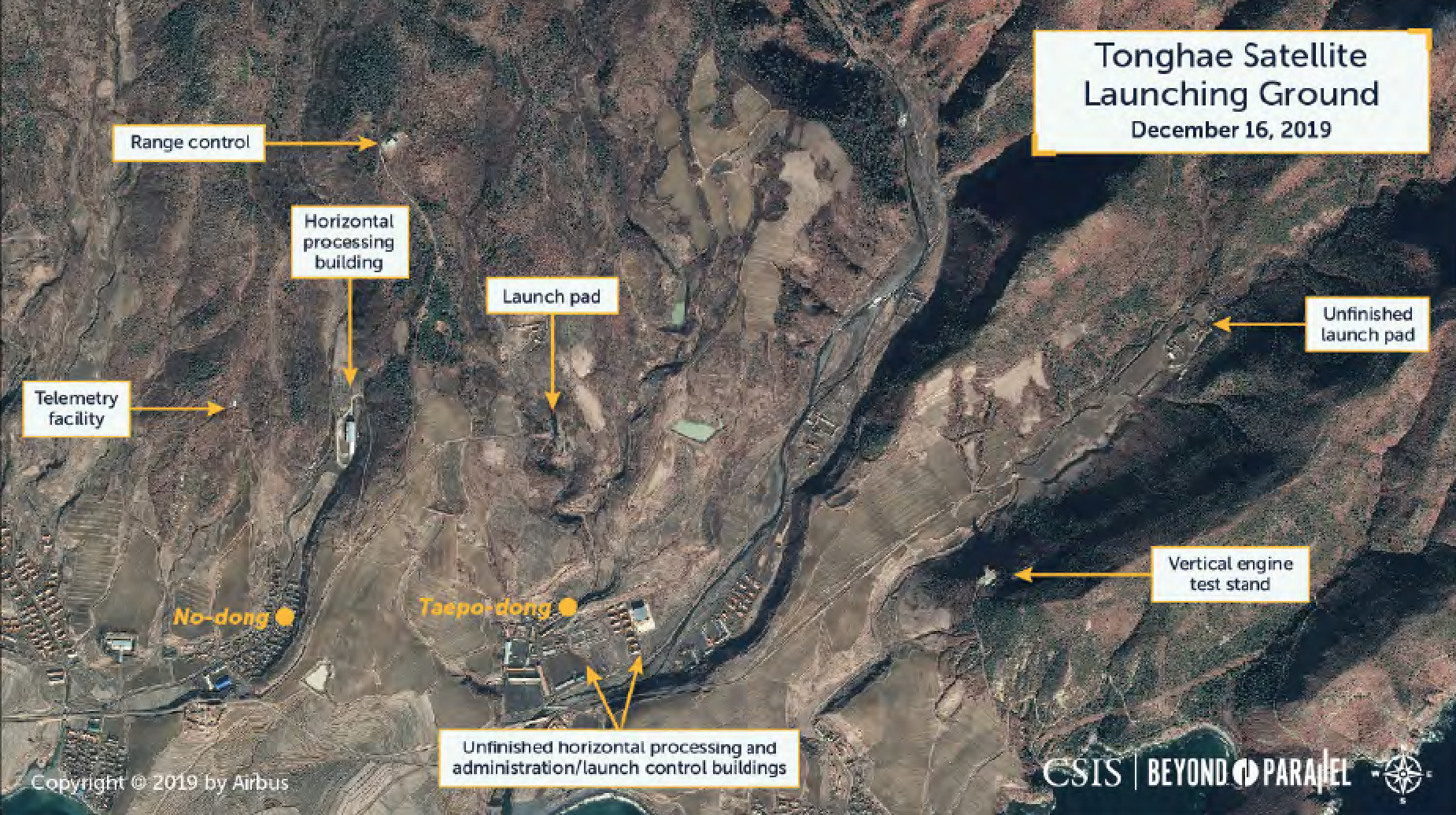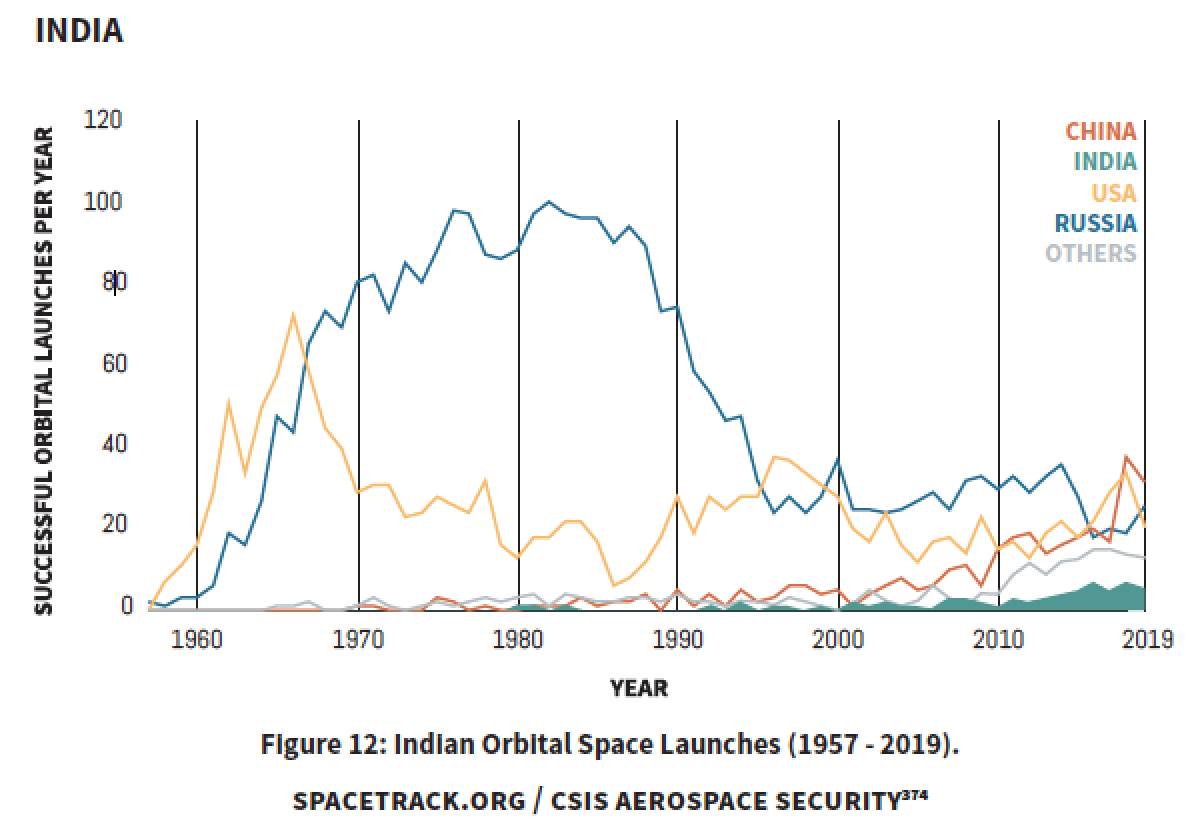Space Threat Assessment 2020 reviews the open-source information available on the counterspace capabilities that can threaten U.S. space systems and which countries are developing such systems. The report is intended to raise awareness and understanding of the threats, debunk myths and misinformation, and highlight areas in which senior leaders and policymakers should focus their attention.
Forward
Much is said these days about the possibility of conflict in space during, before, or perhaps, instead of conflict on land, at sea, or in the air. Why is this the case? The subject is discussed as though it emerged in the last 13 years since the Chinese demonstration of a kinetic ASAT in 2007. In fact, the United States was concerned in 1957 that Sputnik represented a precursor to space-based nuclear weapons. An ASAT program started in the United States in 1958, and the Soviets did similarly. Both superpowers deployed several ASAT systems and performed orbital tests.
Nonetheless, fear on both sides of a serious threat of conflict in space did not emerge until recently. Both the Soviets and the United States understood that the satellites of “National Technical Means” were stabilizing and were keys to de-escalation should a conflict occur. This view changed after the First Gulf War, when space systems moved from being primarily strategic systems to tactical ones providing near real-time support to tactical forces. By that time, the satellites of the Department of Defense and of the Intelligence Community operated and reported almost instantly, and the military services developed the equipment and techniques to acquire, analyze, and distribute space system information very quickly.
Following the First Gulf War, a Russian analysis of the rapid American success noted the efficacy of precision weapons and real-time intelligence. Much of this capability depended on space systems and spurred the Russians and Chinese to a sustained program to develop ASAT capabilities--not only those for physical attack but cyber and electronic attacks as well. In recent years, we have read Russian and Chinese doctrine explaining the importance of ASAT capabilities, and we have seen systems deployed to carry them out.
The situation we confront today was inevitable. Capability is always met with counter-capability. In recognition of this need to defend and to increase our space power in the face of such threats, the United States has wisely created the Space Force and the U.S. Space Command. This is where the people who will design, build, and operate our military space systems reside and where personnel will be trained, careers managed, doctrine developed, and a myriad other elements of a military force undertaken.
Several years ago, an Army general gave a speech where he said, “every company commander depends on space, and takes it for granted.” What a challenge for our Space Force and Space Command to assure that our military is served at every level of command without failing.
Martin C. Faga, Former Assistant Secretary of the Air Force for Space and Director of the National Reconnaissance Office
Types of Counterspace Weapons
SPACE IS AN INCREASINGLY IMPORTANT ENABLER of economic and military power. The December 2017 United States National Security Strategy prioritizes maintaining U.S. leadership and freedom of action in this critical domain, but it notes that:
Many countries are purchasing satellites to support their own strategic military activities. Others believe that the ability to attack space assets offers an asymmetric advantage and as a result, are pursuing a range of anti-satellite (ASAT) weapons. The United States considers unfettered access to and freedom to operate in space to be a vital interest. Any harmful interference with or an attack upon critical components of our space architecture that directly affects this vital U.S. interest will be met with a deliberate response at a time, place, manner, and domain of our choosing.
Counterspace weapons vary in the types of effects they create, and the level of technological sophistication and resources required to develop and field them. They also differ in how they are employed and how difficult they are to detect and attribute. The effects of these weapons can be temporary or
permanent, depending on the type of system and how it is used. The country-by-country assessments that follow this section group counterspace weaponsinto four broad categories: kinetic physical, non-kinetic physical, electronic, and cyber.
> Kinetic Physical
Kintec Physical Counterspace weapons attempt to strike directly or detonate a warhead near a satellite or ground station. A direct-ascent ASAT weapon attempts to strike a satellite using a trajectory that intersects the target satellite without placing the interceptor into orbit. Ballistic missiles and missile defense interceptors can be modified to act as direct-ascent ASAT weapons provided they have sufficient energy to reach the target satellite’s orbit. A co-orbital ASAT weapon differs from a direct-ascent weapon because it is first placed into orbit. When commanded, the satellite then maneuvers to strike its target. Co-orbital ASATs can remain dormant in orbit for days or even years before being activated. A key technology needed to make both direct-ascent and co-orbital ASAT weapons effective is the ability to detect, track, and guide the interceptor into a target satellite. An onboard guidance system requires a relatively high level of technological sophistication and significant resources to test and deploy.
> Non-Kinetic Physical
Non-Kinetic Counterspace weapons, such as lasers, high-powered microwave (HPM) weapons, and electromagnetic pulse (EMP) weapons, can have physical effects on satellites and ground stations without making physical contact. These attacks operate at the speed of light and, in some cases, can be less visible to third-party observers and more difficult to attribute. High-powered lasers can be used to damage or degrade sensitive satellite components, such as solar arrays. Lasers can also be used to temporarily dazzle or permanently blind mission-critical sensors on satellites. Targeting a satellite from Earth with a laser requires high beam quality, adaptive optics, and advanced pointing control to steer the laser beam as it is transmitted through the atmosphere—technology that is costly and requires a high degree of sophistication.3 A laser can be effective against a sensor on a satellite if it is within the field of view of the sensor, making it possible to attribute the attack to its approximate geographical origin. The attacker, however, will have limited ability to know if the attack was successful because it would not likely produce debris or other visible indicators.
> Electronic
Electronic attacks target the means through which space systems transmit and receive data by jamming or spoofing radio frequency (RF) signals. Jamming is a form of electronic attack that interferes with RF communications by generating noise in the same frequency band and within the field of view of the antenna on the targeted satellite or receiver. An uplink jammer interferes with the signal going from the Earth to a satellite, such as the command and control uplink. Downlink jammers target the signal from a satellite as it propagates down to users on the Earth. User terminals with omnidirectional antennas, such as many GPS receivers and satellite phones, have a wider field of view and thus are susceptible to downlink jamming from a wider range of angles on the ground.
The technology needed to jam many types of satellite signals is commercially available and relatively inexpensive. Jamming is a reversible form of attack because once a jammer is turned off, communications return to normal. Jamming can also be difficult to detect or distinguish from accidental interference, making attribution and awareness more difficult. In 2015, General John Hyten, then-commander of Air Force Space Command, noted that the U.S. military was unintentionally jamming its own communications satellites an average of 23 times per month.
> Cyber
Unlike Electronic attacks, which interfere with the transmission of RF signals, cyberattacks target the data itself and the systems that use this data. The antennas on satellites and ground stations, the landlines that connect ground stations to terrestrial networks, and theuser terminals that connect to satellites are all potential intrusion points for cyberattacks. Cyberattacks can be used to monitor data traffic patterns (i.e., which users are communicating), to monitor the data itself, or to insert false or corrupted data in the system. While cyberattacks require a high degree of understanding of the systems being targeted, they do not necessarily require significant resources to conduct. Cyberattacks can be contracted out to private groups or individuals, which means that a state or non-state actor that lacks internal cyber capabilities may still pose a cyber threat.
A cyberattack on space systems can result in data loss, widespread disruptions, and even permanent loss of a satellite. For example, if an adversary can seize control of a satellite through a cyberattack on its command and control system, the attack could shut down all communications and permanently damage the satellite by expending its propellant supply or damaging its electronics and sensors. Accurate and timely attribution of a cyberattack can be difficult, if not impossible, because attackers can use a variety of methods to conceal their identity, such as using hijacked servers to launch an attack.
> Threat Characteristics
The types of counterspace threats described above have distinctly different characteristics that make them more suitable for use in some scenarios than others. As shown in Table 1, some types of counterspace threats are difficult to attribute or have fully reversible effects, such as mobile jammers. High-powered lasers, for example, are “silent” and can carry out an attack with little public awareness that anything has happened. Other types of counterspace weapons produce effects that make it difficult for the attacker to know if the attack was successful, and some produce collateral damage that can affect space systems other than the one being targeted.
North Korea
North Korea Successfully Orbited its first Satellite in December 2012 after three failed attempts in July 2006, April 2009, and April 2012. Its fifth attempt, in February 2016, successfully placed a second satellite in orbit. Both successful orbital launches from North Korea have been on the Unha-3 SLV, whose militarized adaptation is likely the same vehicle outfitted with a reentry vehicle in place of an orbital satellite.321 Like many other spacefaring nations around the globe, North Korea’s space capabilities are closely tied to its ballistic missile development.

A North Korean law journal referenced the close relationship between space capabilities and ballistic missiles, stating “it is an undeniable truth that satellites launched into orbit by many countries around the world were made possible by rocket propulsion.” While defending the country’s satellite launching program, the article continued to state that the main difference between a peaceful space launch and a ballistic missile is whether the launch vehicle is furnished “with a satellite or a bomb.”
Although reaching orbit is a significant achievement, many experts doubt that the two successfully launched satellites perform all of the functions the North Korean government claims. In a 2016 interview with the Associated Press, the head of the North Korean space agency stated his intent to continue launching Earth observation satellites, and his aspirations to send a mission to the moon around 2026. He was quoted as saying, “Even though the U.S. and its allies try to block our space development, our aerospace scientists will conquer space and definitely plant the flag of the DPRK on the moon.”
There is little indication that North Korea is making substantial efforts to build or sustain a space industrial base, but its missile program is advancing. There were 11 separate North Korean missile tests in 2019 alone, which involved as many as 20 rockets in total. Additional satellite footage taken in early 2020 showed increased activity at a known missile launch site, possibly signaling more tests in the near future.
Space Launch Facilities
North Korea has two established launching areas for space capabilities: the Tonghae Satellite Launching Ground and the Sohae Satellite Launching Ground. The Tonghae Satellite Launching Ground is North Korea’s oldest ballistic missile and space launch facility, although a successful orbital launch has never been achieved at the facility. According to December 2019 satellite imagery, there was increased activity at the site, including a group of people and possibly crates, but no sign of major renovations that would have to take place to prepare the facility for a vehicle test. However, North Korea has used mobile launching platforms for all recent land-based ballistic missile tests, which could be conducted in the grounds of Tonghae.
The Sohae Satellite Launching Ground showed initial steps of disassembly in satellite imagery in the summer of 2018, but reassembly began again after U.S - North Korea Summits in Singapore and Hanoi.In late 2019, North Korea conducted two engine tests at the Sohae Satellite Launching ground, believed to be modified liquid-fueled engines for long-range missiles.While the specifics of the tests were unconfirmed, KCNA state media referred to the successful tests as “defence science achievements” that will “have an important effect on changing the strategic position” for the country.Although conducted at a satellite launching pad, experts assess that it was likely another missile test or a step towards ICBM development, rather than a space vehicle launch.
Space Organization and Doctrine
North Korea keeps its doctrine and operational concepts largely under wraps, including what is released about its counterspace capabilities. The absence of discussion about counterspace capabilities that could threaten the U.S. military is unusual given the aggressive rhetoric used by the regime in touting its nuclear and missile programs. The country continues to advocate internationally for its right to a sovereign space program.
When the regime has spoken about its space program at the United Nations, delegates speak of respect of international norms to maintain peaceful development and use of outer space, including the North Korean space program’s right to help the country grow economically. In March 2009, North Korea became a signatory to two major UN space treaties: the Outer Space Treaty of 1967 and the Convention on Registration of Objects Launched into Outer Space of 1974. Four years later, in April 2013, the country’s Supreme People’s Assembly established the National Aerospace Development Administration (NADA), the official North Korean space agency. Additionally, space has often been included in five-year plans that the regime has put forward.
In October 2017, a delegate to the United Nations was reported in state media as saying “peaceful development of outer space is actively conducted in accordance with the 2016-2020 plan for national outer space development.” As reported, this plan included an aim to launch a geostationary satellite—a much more challenging feat which would require a more powerful launch vehicle. State media reported a successful ground test of a new launch vehicle for this purpose, but it has not noted any attempts at an actual launch. The regime hopes to use satellites to monitor crop and forestry growth as well as to improve communication capabilities. The plan expressed a goal to field a satellite communication system by 2019, though there is no indication that goal was achieved.
Counterspasce Weapons
Kinetic Physical
Current space launch vehicles and ballistic missiles demonstrated by North Korea could serve as the basis for a kinetic ASAT capability, but many technological hurdles remain. To date, North Korea has not tested, or indicated that it is attempting to develop, a direct-ascent or co-orbital ASAT capability. It is unlikely that North Korea could quickly gain the technology for an effective direct-ascent or co-orbital ASAT weapon, as it has only succeeded in placing two satellites into orbit, the operation of which are not confirmed outside state media. This additional capability would also require onboard sensors (e.g., optical, infrared, radar) and a guidance system to steer the weapon into a target satellite.
Non-Kinetic Physical
The technology necessary to develop directed energy weapons, such as lasers that are able to dazzle or blind the sensors on satellites, requires a level of sophistication that North Korea likely does not possess. It is possible, however, that North Korea could develop a crude EMP weapon for use against space assets. In 2017, North Korea successfully tested a hydrogen bomb underground, a claim that was confirmed by South Korea and Japan. Officials from Pyongyang released a photo of the hydrogen bomb and asserted that the bomb is able to fit on an ICBM. Kim Jong-un has called for further improvements in nuclear bombs similar to this test in the “Songun” spirit, which places the military first. In January 2020, KCNA reported that Kim Jong-un declared the world would soon see a new strategic weapon, adding that there will never be denuclearization on the Korean peninsula.
Electronic
North Korea has acquired and is constantly using electronic forms of attack against varying space systems. In 2010, South Korean Defense Minister Kim Tae-young said in a speech to parliament that “North Korea has imported vehicle-mountable devices capable of jamming GPS signals from Russia.” These downlink jamming systems reportedly have an effective radius of 50 to 100 km. North Korea began using this jamming equipment against South Korea in August 2010, but South Korean forces could not pinpoint the location of the jammers at that time because the jamming lasted just 10 minutes in each instance.
Cyber
Under the Kim Jong-un regime, North Korea has used its cyber forces frequently, first launching attacks on South Korea and the United States, then branching out to others. According to CrowdStrike, North Korean hackers have the second- fastest breakout time (the time needed for hackers to achieve their objectives in an attack) of any hacking organization in the world, behind Russia. North Korea’s malicious cyber activity tends to focus on financial targets or inter-Korea issues. A majority of the cyberattacks stemming from North Korea are “linked to currency generation and economy-bolstering efforts for the Kim regime.”
Summary
North Korea has demonstrated growing capabilities in two counterspace weapons categories: electronic and cyber. It is also developing some of the necessary technologies to field a non-kinetic physical nuclear EMP counterspace weapon through its nuclear program, but this does not appear to be the intent of those activities. Although North Korea has demonstrated its dedication to increasing the range of its ICBM-class missiles, its limited number of successful orbital launches suggest that the country is far from developing the capabilities needed to pose a significant kinetic physical threat to foreign satellite systems. The only significant risk of non-kinetic physical attack from North Korea is high altitude nuclear detonation, a devastating, irreversible counterspace attack that would indiscriminately affect systems in the target satellite’s orbital regime. Importantly, North Korea is improving its electronic warfare capabilities, as demonstrated in continued GPS jamming and spoofing operations, and is continuing to use cyberattacks against a variety of targets worldwide.
India
India joined the world stage as a rising space power by launching its first satellite from the Satish Dhawan Space Center in 1980. India has since developed highly successful launch vehicles, a range of communications, imaging, and other critical satellites, and is beginning serious development of counterspace capabilities. While India has no overarching national space policy yet, the government of India is in the process of creating one.

Currently, it does have various organizations dedicated to the space domain in both the military and civil sectors, each with supporting policies and doctrine. Among these organizations is the principal space organization in India, the Indian Space Research Organization (ISRO), which is responsible for maintaining the SLVs and spaceports of India. Currently, India has two operational orbital launch vehicles, the Polar Satellite Launch Vehicle (PSLV) and the Geosynchronous Satellite Launch Vehicle (GSLV). These two vehicles launched six times in 2019, representing only a small portion of the 67 total Indian launches since 1980 from the Satish Dhawan Space Centre. India made history in 2017 with the largest number of satellites on any single mission, launching 104 satellites with one PSLV, breaking the previous record of 37 satellites held by Russia since 2014. All but three of these satellites were foreign owned.
The Satish Dhawan Space Center has been India’s only major spaceport since it began launching in 1980. However, due to the anticipated increase in demand for national and commercial space launch in the coming years, the Indian government has begun the land acquisition process for the construction of a new spaceport. The proposed spaceport, to be located in the southern state of Tamil Nadu, is planned to mainly service India’s newest launch vehicle, the Small Satellite Launch Vehicle (SSLV). A derivative of the PSLV, this new Indian launch vehicle is rated to carry “up to 500 kilograms to mid-inclination low Earth orbits and 300 kilograms to [sun-synchronous orbit (SSO)].” The location of the proposed spaceport will allow for launching southward into a polar or near-polar orbit, which is difficult from the Satish Dhawan Space Center due to the need to maneuver around Sri Lanka.
Only three countries—China, the Soviet Union, and the United States— have ever “soft-landed” on the lunar surface. In 2009, India successfully launched the Chandrayaan-1 spacecraft, which was designed to orbit the moon and conduct a hard-landing for the purpose of targeting and practicing a future soft-landing. In 2019, the Chandrayaan-2 spacecraft was placed on a GSLV and launched into lunar orbit. While on approach to the lunar surface to attempt a soft-landing, the Vikram Lander lost contact with the ISRO and crashed into the lunar surface. After about a month of attempting to re-establish contact with the lunar lander, the Indian government made an official announcement that they had lost contact and were unable to recover the spacecraft. However, this failure has only reinvigorated the Indian space program and public. In an announcement on January 1, 2020, Chief Kailasavadivoo Sivan, head of the ISRO, stated that the top priorities for the ISRO in 2020 are a Chandrayaan-3 mission to the lunar surface and the Gaganyaan human spaceflight program, though it is unlikely that either will launch before 2021. The Chandrayaan- 3 mission will similarly attempt to conduct a soft-landing on the lunar surface. When asked if a crewed mission to the moon was in the near future for India, Sivan said, “definitely, but not immediately.” Four Indian astronauts will be sent to Russia for 11 months to receive training in preparation for the Gaganyaan program. Additional program- specific training will also take place in India.
Organization and Doctrine
India does not have an official military department focused on space. It instead created a separate agency, the Defence Space Agency (DSA), to coordinate between and command the space assets of the Indian Army, Navy, and Air Force, including India’s new direct- ascent ASAT capabilities. According to the twostar general appointed to head the DSA, “the agency will eventually grow into a full-fledged Space Command in the years ahead.” To date, however, there is no confirmed timeline for this growth. Within the DSA, India established the Defence Space Research Organ- Vikram Lander and Pragyan Rover. The Vikram lander was launched on the Chandrayaan-2 mission, but it did not achieve a successful soft landing on the lunar surface. isro ization (DSRO) in late 2019 to further develop and test counterspace systems and related technologies. In late July 2019, India’s top strategic planners from several agencies gathered to begin to establish new policies and doctrine for future military and non-military uses for space. Called IndSpaceEx, the strategic planners were led through a wargaming simulation that was meant to assess military assets of other leading space powers—namely the United States, China, and Russia—to better assess the level to which India must counter international space threats. The session’s conclusion was that future wars may be dominated by activities in the cyber and space domains, leading to asymmetric advantages or disadvantages. A 2019-2020 annual report released by the Government of India’s Department of Space detailed initial steps of an official space policy for the country. This policy will “support the pursuance of space activities by various agencies in India including private sector and start-up companies in the aerospace sector.” It is clear through India’s military space reorganization, renewed focus on commercial partners, and it’s test of a direct-ascent ASAT in March 2019 that the Indian leadership views space as a key operational domain.
Mission Shakti
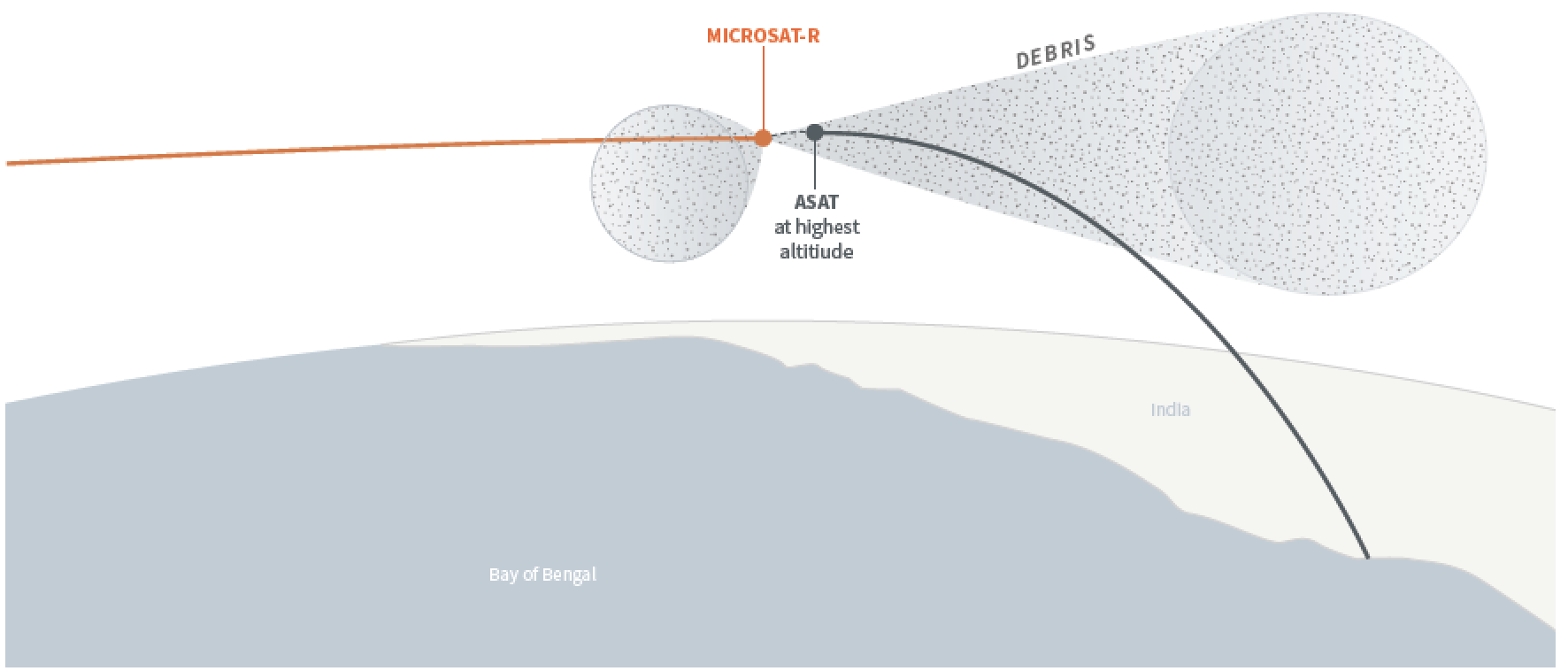 Depiction of Kinetic Physical ASAT Test by India in 2019. Muted international outcry in response to this ASAT test was, in part, due to the low amount of debris created because of the slight downward trajectory of the missile on impact. aerospace security project / emily tiemeyer
Depiction of Kinetic Physical ASAT Test by India in 2019. Muted international outcry in response to this ASAT test was, in part, due to the low amount of debris created because of the slight downward trajectory of the missile on impact. aerospace security project / emily tiemeyer
On March 27, 2019, India successfully launched a Prithvi Delivery Vehicle Mark-II (PDV MK-II) missile defense interceptor at one of its own satellites. Launched in late January 2019, the target satellite, Microsat- R, was specifically placed in a low-altitude sun-synchronous orbit as the target for an ASAT test. After the successful test in March, independent analysts realized that an earlier attempt to intercept the satellite on February 12 of the same year failed.
What was perhaps most notable about the Indian ASAT test was the muted international outcry that occurred afterward. This was likely due in part to the minimal amount of orbital debris created—only about 400 pieces remained in orbit immediately after the test, compared to the over 3,000 pieces of debris created during the 2007 Chinese ASAT test. The Indian ASAT test took place at a relatively low altitude, and at the time of impact, the interceptor was on a downward trajectory. This resulted in much of the debris having a downward trajectory, allowing it to be more quickly deorbited. Given these factors, it is likely that the Indian government was attempting to limit the potential for long-lasting orbital debris. Since the test, a majority of the debris has deorbited, and by the end 2019, just 18 pieces of debris large enough to track remained in orbit.
The Indian ASAT test did not receive the same level of international outcry as the Chinese ASAT test, in part because it produced much less orbital debris. The United States, for example, only had one government official speak out against the test. NASA Administrator Jim Bridenstine decried the test because some pieces of debris were pushed to a higher altitude, threatening the astronauts on the International Space Station. While public international outcry was minimal, Pakistan was one of few states to openly denounce the test, urging all countries to “condemn India’s action and strengthen international laws regarding the militarization of space.” Additionally, the Union of Concerned Scientists denounced the test, expressing that this test harmed international efforts to prevent further weaponization of outer space.
Summary
Although India has had a recent successful direct-ascent ASAT test, other types of counterspace weapons are far from developed. As India focuses more on building out its space assets, as well as its counterspace assets, subsequent counterspace weapons tests may occur. While the 2019 ASAT test has certainly caused great debate in the international space community, the muted official international response sets a different precedence from the Chinese 2007 test. With little to no repercussions, India demonstrated that a lower-altitude ASAT test may be accepted by the international community.
Others
While the previous chapeters have been dedicated to the countries making the largest strides in counterspace capabilities— China, Russia, Iran, North Korea, and India—they are not the only ones thinking strategically about the changing space environment. This chapter includes significant discussion and developments related to counterspace capabilities in other countries and nonstate actors.

France
As the third oldest space program in the world. France has accomplished much since it first established its national space agency, the Centre national d’études spatiales (CNES), in 1961. France launched its first satellite in 1965, led the development of the Ariane family of launch vehicles, and became one of the foremost European space powers through its strong relationship with the European Space Agency (ESA).417
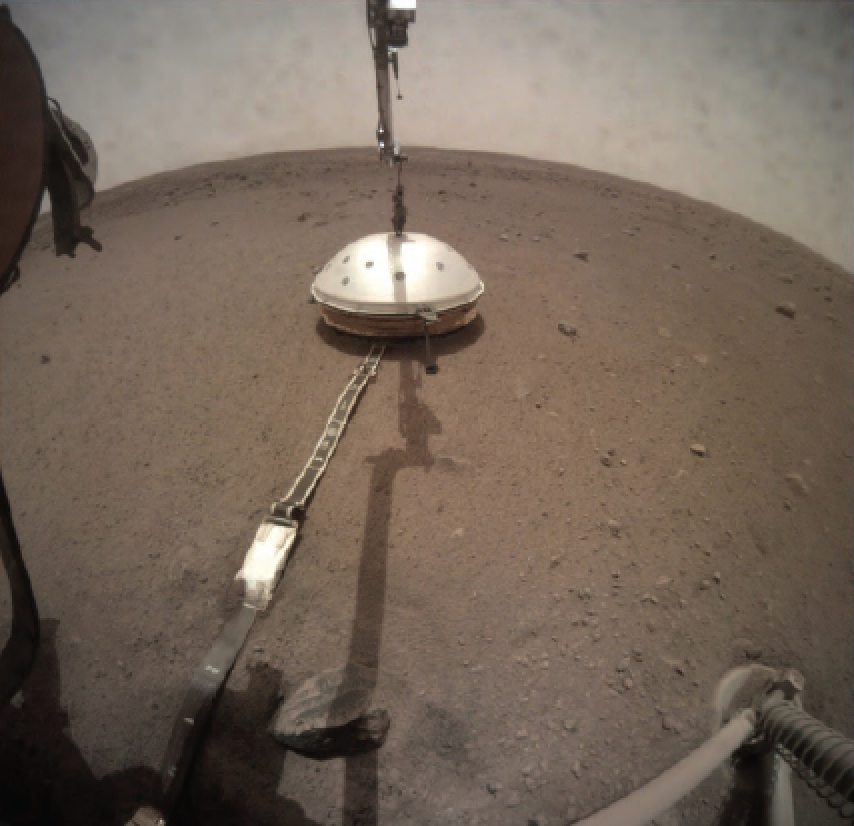
Deployment of the SEIS Protection Dome on Mars.
nasa / jpl-caltech
In 2018, the CNES was a key partner of NASA’s Mars Discovery Program, providing the InSight (Interior Exploration using Seismic Investigations, Geodesy and Heat Transport) mission. InSight deployed a seismometer, named SEIS (Seismic Experiment for Interior Structures), which measures “Mars’ tectonic activity to learn more about its structure, for example the size of its core and the thickness of its mantle.”InSight landed on Mars in 2018 for its planned two-year mission, and in April 2019, the SEIS seismometer detected and recorded the first “Marsquake,” allowing scientists to study the slight tremors detected on the Martian surface.
Recent events have triggered changes in France’s overall space policy. In September 2018, France publicly charged Russia with interfering with the operation of one of its satellites in GEO. The Athena- Fidus, a jointly operated French-Italian military satellite, provides broadband military communications. France alleged that the Russian satellite, known as Luch or Olymp-K, maneuvered close enough to Athena-Fidus in 2017 to intercept military communications.
Following this public denunciation of Russian space activities, France issued a new Space Defense Strategy in 2019. Among other things, the French strategy calls for the creation of a Space Command under the Air Force and renaming the Air Force to the Air and Space Force. The strategy notes that “renewed analysis of the space environment and its threats, risks and opportunities, as well as the recognition of the strategic nature of the space assets for France force our country to revisit its model in order to remain a leading space power.” The Space Defense Strategy further declares that France will establish a “space defense capacity” in order to “enable the armed forces to impose a peaceful use of space, deter unfriendly or hostile acts against our space assets, and be able, as the case may be, to defend our space-based interests.” France has also committed to increasing its military space budget by 700 million euros between 2019 and 2025 to support the creation of Space Command and pursue “active defense” satellite technologies. The defense of space assets appears to be in response to the interference France felt was caused by Luch.
 Space Orbital Launches from Other Nations (1957 - 2019). This figure includes orbital launches from nations such as New Zealand and Japan, as well as the European Space Agency. spacetrack.org / csis aerospace security
Space Orbital Launches from Other Nations (1957 - 2019). This figure includes orbital launches from nations such as New Zealand and Japan, as well as the European Space Agency. spacetrack.org / csis aerospace security
In a speech announcing the new strategy, French Minister of the Armed Forces Florecne Parly spoke at length about the changes. In some of the most direct and specific language by a government official from any nation on space defense, the defense minister said, “I want to be precise: active defence is not an offensive strategy, what it is about is self-defence.” She went on to add that, “If our satellites are threatened, we will consider dazzling those of our opponents. We reserve the time and means of the response: this may involve the use of high-power lasers deployed from our satellites or from our patrol nano- satellites.” Through these remarks Parly sheds further light on France’s plans to develop and deploy “bodyguard” or “patrol” satellites to protect its space assets, as well as its plans to mount lasers on satellites in order to dazzle or blind satellites that may be threatening French assets.
A laser mounted on satellites is theoretically possible but faces some technological hurdles. Laura Grego from the Union of Concerned Scientists explained that “dazzling from accompanying satellites (probably not ‘nano’ satellites unless that definition is very generous) or onboard might stop other slow moving proximity operations satellites from observing their satellite [targets] or to make it hard for them to use lidar for getting really close.” Dr. Grego went on to assert that it would be hard to use lasers on cross-orbit attacks or direct-ascent ASAT weapons.
France’s public posture toward protecting its space capabilities is shifting. The country’s leaders are indicating a move toward active defense in space, which has contributed to a broader public debate on the proper use and development of counterspace weapons. While countries like China and Russia have been extensively developing offensive counterspace weapons, such as jamming and spoofing capabilities, France seems to be considering a different strategy: defensive capabilities on orbit. However, the country’s policies appear to be in flux, and there is little public indication of how quickly France plans to pursue this new direction.
Israel
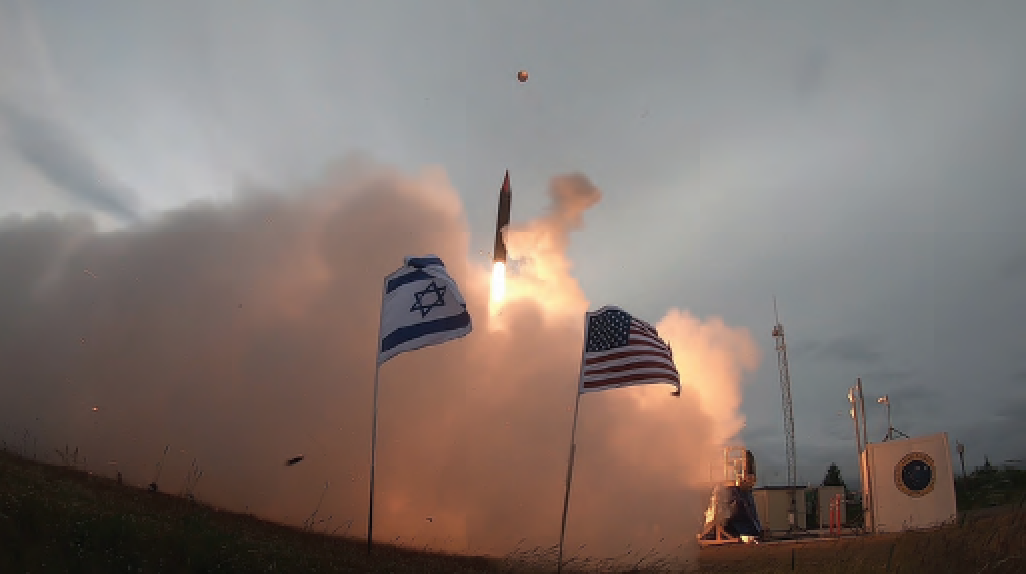
Israeli Missile Interceptor, Arrow-3, was tested July 2019 out of the
Pacific Spaceport in Alaska.431 Designed to intercept medium-range
ballistic missiles, the Arrow-3 system has been speculated to also be
capable of performing direct-ascent anti-satellite operations.432 missile
defense agency
In July 2019, the United States and Israel jointly tested the Arrow-3 missile interceptor. While not publicly listed as a direct-ascent ASAT weapon, “the Arrow- 3 interceptor successfully demonstrated an engagement capability against the exo-atmospheric target during the test.” Speculation of the Arrow-3 system being used as an ASAT weapon began in 2009 when leading space military experts pointed out that “Israel’s planned Arrow-3 high-altitude ballistic missile defense system could relatively easily be adapted to destroy Iranian spy satellites if and when Tehran manages to deploy high-resolution orbiting vehicles.”
The Israeli company Regulus claims to have spoofed a Tesla Model 3 using the Navigate on Autopilot (NOA) system. The purpose of the NOA system is to follow a predetermined route maintained by using GPS and Google Maps technology. The spoofing targeted the relationship between the Tesla Model 3’s NOA system and the GPS it relied on to maintain autopilot. The test itself took place on an interstate and made the car believe it was further along on the route, causing it to make an incorrect turn into a rest stop instead of the planned exit further down the road. In response to these claims, Tesla stated that the test was only a promotional stunt and that they have no safety concerns with the Tesla-3’s NOA.
Israel has also begun development of a ground-based and plane-mounted high-energy laser defense system designed to target threats in the air. Currently it has no stated counterspace implications, but the technology could be adapted to perform some counterspace operations. With a power level of 50-100kW, this airborne laser could be capable of dazzling or even blinding satellites in LEO.
Japan
In the past year, Japan has made progress toward setting up a new Space Domain Mission Unit, a military organization meant to protect Japanese space assets as more countries are moving to further weaponize space through the testing and development of kinetic and non-kinetic weapons.434 Citing Japan’s need “to protect itself from potential threats as rivals develop missiles and other technology,” Prime Minister Shinzo Abe said this new organization will work closely with its American counterpart, the United States Space Force. The Space Domain Mission Unit will also cooperate with the newly re-established U.S. Space Command and Japan’s own civil space agency, the Japan Aerospace Exploration Agency (JAXA).435 With a small core established in 2020, the Space Domain Mission Unit plans to be fully operational in 2022 to “bolster capability and system[s] in order to secure space superiority.”436 After its establishment, the Space Domain Mission Unit will be responsible for operating the ground stations necessary to conduct these defense operations.437
Japan is also reportedly considering the development of active defenses to protect its space systems. Using robotic arm technology developed by JAXA, the Japanese government is debating options to develop a co-orbital satellite defense system to deter attacks on Japanese satellites. This system, which would intercept an attacking satellite in order to defend another Japanese space asset, could be launched as early as the mid-2020s.438 The government is also reportedly considering options to disable hostile satellites through electronic and cyber means.439
Spoofing in the Mediterranean Sea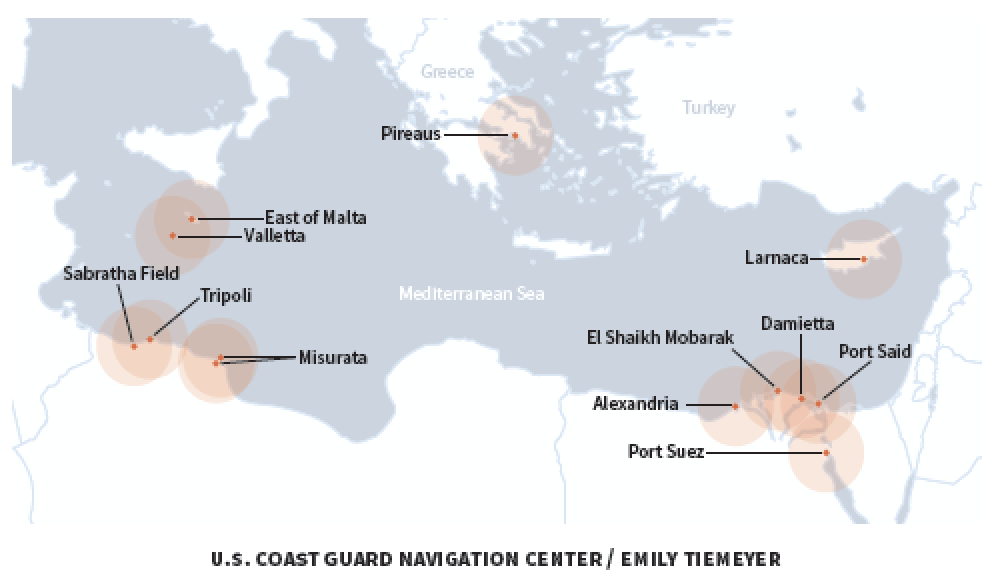 Civil and Commercial Marine GPS users reported consistent loss of GPS signal in the Mediterranean Sea and surrounding areas throughout 2019. These outages ranged from the coast of Libya to Greece and Egypt’s Suez Canal. The U.S. Maritime Administration issued alerts that specifically mention the possibility of GPS interference in the Eastern and Central Mediterranean regions.441 The increased instances of GPS jamming have led captains to suppress their AIS data and switch to receive only. This has led to a decrease in situational awareness on the sea.
Civil and Commercial Marine GPS users reported consistent loss of GPS signal in the Mediterranean Sea and surrounding areas throughout 2019. These outages ranged from the coast of Libya to Greece and Egypt’s Suez Canal. The U.S. Maritime Administration issued alerts that specifically mention the possibility of GPS interference in the Eastern and Central Mediterranean regions.441 The increased instances of GPS jamming have led captains to suppress their AIS data and switch to receive only. This has led to a decrease in situational awareness on the sea.
In April of 2019, Japan deployed a Hayabusa- 2 probe system to an asteroid, Ryugu, which contained a small carry-on impactor (SCI). The SCI is an explosive projectile able to be launched at the asteroid to form an artificial crater. This explosive, which created rubble for Hayabusa-2 to collect and bring back to Earth as samples, could be placed on a satellite and be used as a co-orbital anti-satellite weapon.440
United Kingdom
The United Kingdom has begun restructuring its military space organization, although it does not plan to create a separate military service for space. The current restructuring effort should result in a two-star major general becoming the director of Space within the Ministry of Defence, supported by policy and capabilities teams.443 This comes after the U.K. government declared space as part of its critical national infrastructure in 2015 and more recently as a warfighting domain.444 While the UK has not explicitly endorsed the development of space defense systems and counterspace weapons, the requisite technology is within its reach. For example, the United Kingdom is developing its own high-energy laser for anti-drone and missile defense. These lasers, while not directly cited as counterspace weapons, have the potential to be further developed into counterspace capabilities.445
Non-Sate Actors
In 2019, reports emerged of position, navigation, and timing (PNT) jamming in northeastern China, disrupting civilian aircraft flying over the area. Authorities were able to trace the jamming origin to a farm in Heilongjiang province near the city of Harbin. Frustrated by a local gang’s hijinks of using drones to supposedly infect local farmers’ pigs with African swine fever—a disease deadly to pigs, but harmless to humans—the farmer used PNT signal jamming to protect his herd. The gangs were infecting local pigs to force farmers to lower the prices and then would resell the pork to the public as “healthy” for the full price.446
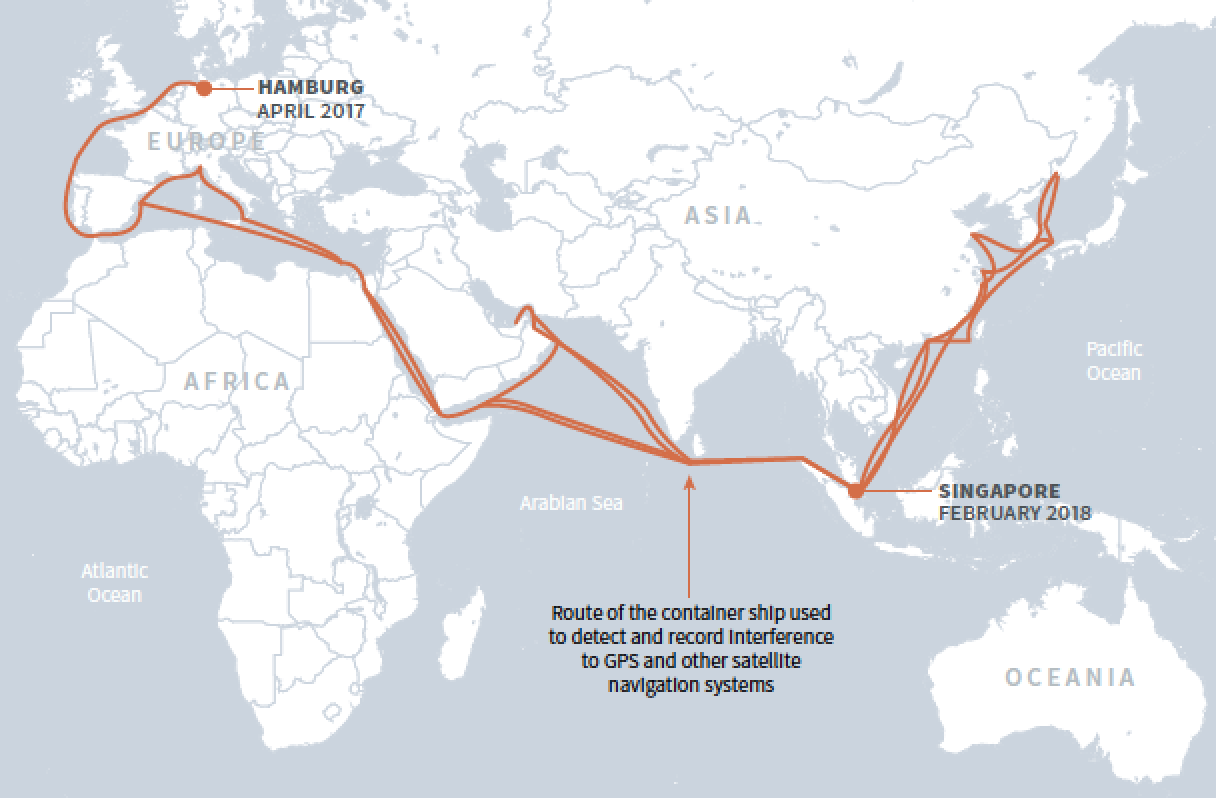 The Journey of the Basle Express. The Basle Express was a cargo ship outfitted with GPS receivers designed to track and collect GPS interference. The ship travelled from Germany to Singapore tracking and detailing many instances of GPS interference. German Aerospace Center.
The Journey of the Basle Express. The Basle Express was a cargo ship outfitted with GPS receivers designed to track and collect GPS interference. The ship travelled from Germany to Singapore tracking and detailing many instances of GPS interference. German Aerospace Center.
In 2018, at Hong Kong’s 10-year celebration of the Wine and Dine Festival, a drone light show over Victoria Harbor was disrupted by GPS jamming, which caused 46 drones to fall from the sky, resulting in $127,500 in damages.447 In response to questions about the incident, the board’s executive director, Anthony Lau Chun-hon, said that “the [jamming] signals were so strong that many of them just dropped from the air.”448
In April of 2017, a commercial container ship, the Basle Express, left Hamburg, Germany on a research mission equipped with receivers designed to pick up on interference. The Basle Express mission was designed to sense levels of jamming and spoofing in different areas of the world.449 While travelling around Europe, the Middle East, Africa, and Asia, the ship’s crew detected strong interference “at some of the world’s largest seaports, including Jeddah in Saudi Arabia, Singapore, Hong Kong, and Shanghai, and less often, on the open sea.”450 With many commercial vessels poorly suited to operating in a world where GPS is not guaranteed, some experts are recommending that new anti-jamming systems will need to be created to ensure that commercial shipping can continue unthreatened in an increasingly technology-dependent world.451
Summary
In the last year, more states are considering the development of offensive and defensive counterspace capabilities to protect space systems from attacks. Nations are moving to reorganize their national security space enterprise, as the United States did in 2019, to better address the growing uncertainty and threats in the space domain. Jamming and spoofing technologies are also being used around the world by non-state actors in both conflict zones and thriving seaports, to gain military and economic advantage. Collectively, these developments are making the space environment more dynamic and uncertain—a trend that is likely to continue in the coming years.


